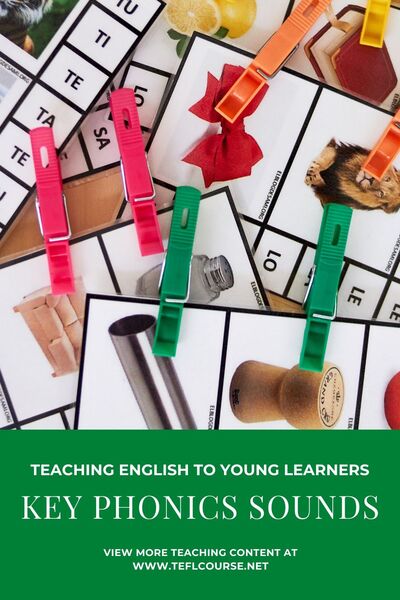Teaching Key Phonics Sounds to Early Learners

A key barrier to achieving fluency for ESL students is a mastery of individual phonics sounds. My experience with ESL students from Southeast Asia has led me to focus on techniques for the particularly difficult L, R, M, and P phonics sounds. In this essay, I propose methods for using the straight arrow ESA lesson plan to introduce and drill phonics sounds with young learners.
Table of Contents
Do you want to teach English abroad? Take a TEFL course!
This post was written by our TEFL certification graduate Ethan W. Please note that this blog post might not necessarily represent the beliefs or opinions of ITTT.
The Engagement Stage
The Engage portion of the lesson should serve as an interesting introduction to ignite student curiosity. Students are shown a series of pictures, ideally on a smartboard, if not, then with teacher-generated props and posters. Each picture depicts a noun that students would be familiar with in their native language. Students would be asked to match the letters L, M, P, and R to each of the pictures. The teacher should further encourage and excite students by making motions and sounds to accompany each picture, like manic gestures and hoots for "M is for Monkey." Here engaging phase should provide a base amount of pre-teaching and familiarization with phonics sounds before starting speaking exercises and drills.
Also Read: Do I need a visa to teach English abroad?
The Study Stage
In this lesson, the productive skill of speaking will be emphasized to provide students with the instant gratification of mastering new skills while laying down an important foundation of their later language acquisition and fluency. Speaking drills in the study phase will focus on a reasonably close pronunciation of each phonic sound. Special attention is given to clipping away extraneous "ahh" sounds when reading the letter as a stand-alone phonics sound. Students will ask to mirror the teacher's comically overemphasized mouth shapes when pronouncing each sound. The class as a whole will repeat each sound three times in a call-response fashion with the teacher. The next step of the study phase teaches students how to break the phonics in the lesson into continual sounds and stop sounds. Students will listen to the teacher pronounce each phonic sound. The teacher will explain that sounds like M, L, and R make a longer sound. The phonic sound for P is very brief and very quiet, making it a stop sound. The teacher will make the sounds for each phonic. With their eyes closed, students will raise their hands when they hear continual sounds and put their heads on the desk for the stop sound. The exercise will be repeated at various speeds for a few rounds until each student can complete the action correctly. Students participate in the exercise with eyes closed to circumvent shyness over giving an incorrect answer in front of classmates. Motions are included to provide an element of play and stimulation for young students to de-escalate the stress of confronting new phonics. Students are given a study sheet in the second segment of the study phase. Students will practice writing the uppercase and lowercase forms of each letter and match words from a word bank to the correct initial phonic letter. (E.G., matching "mouse" to the "m" phonic.)
Also Read: Are there any age limits for TEFL teaching?
The Activate Stage
The activate phase of the lesson occurs as a group activity. Students receive an identical list of five words for each phonetic sound. Students spend the first few minutes of the activity, drilling each list with the teacher. This ensures that each student can read the majority of their list with satisfactory pronunciation before the game begins. The teacher uses a stopwatch or timer to record how quickly each student can read their list of words. There is separate scoring for the M, L, and R lists. The game consists of three rounds where students read their list with increasing speed. The teacher takes steps to encourage and empower students and to withhold the overcorrection of mispronunciation unless a student's particular error could be used to help the individual and the class at large. Students are encouraged to read their set of lists causally in the first round; speed increases in the second round and again in the third. The teacher congratulates the students for completing their list. The teacher takes notes on words that the majority of students struggle with so that difficult words and sounds can be emphasized and reviewed in later lessons.
Do you want to teach English abroad? Take a TEFL course!
Incorporating an engaging element of play can benefit a class when encountering the potentially intimidating introduction of vital phonics sounds for learning English speaking skills. Each part of the lesson provides students with speaking and listening practice for difficult phonics sounds while building confidence and comfort with their productive skills.
Apply now & get certified to teach english abroad!
Speak with an ITTT advisor today to put together your personal plan for teaching English abroad!
Send us an email or call us toll-free at 1-800-490-0531 to speak with an ITTT advisor today.
Related Articles:
- 5 Highlights of Teaching English in Argentina
- 8 Traveling Power Couples Teaching English Abroad You Should Follow Right Now
- The 10 Best Destinations for Teaching English Abroad in 2018
- The Best Government Programs For Teaching English Abroad
- Teaching English In South Korea - The Salary and Budget Guide
- The 7 Biggest Myths About Teaching Abroad Alone as a Woman




